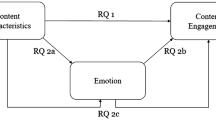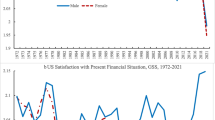Abstract
Subjects rated the power, competence, warmth, and honesty of stimulus persons whose voices systematically and independently varied along the dimensions of vocal attractiveness and vocal maturity. The results revealed that the effects of vocal attractiveness on person perception can be attenuated or augmented by variations in vocal maturity; and that the effects of vocal maturity on impressions can be similarly modified by level of attractiveness. Implications of the data for the understanding of vocal stereotypes are discussed.
Similar content being viewed by others
References
Berry, D.S. (1990 a). Vocal attractiveness and vocal babyishness: Effects on stranger, self, and friend impressions.Journal of Nonverbal Behavior, 14 141–153.
Berry, D.S. (1990 b). What can a moving face tell us?Journal of Personality and Social Psychology, 58, 1004–1014.
Berry, D.S. (1990 c). Taking people at face value: Evidence for the kernel of truth hypothesis.Social Cognition, 8, 343–361.
Berry, D.S. (1991a). Accuracy in social perception: Contributions of facial and vocal information.Journal of Personality and Social Psychology, 61, 298–307.
Berry, D.S. (1991b). Attractive faces are not all created equal: Joint effects of facial babyishness and attractiveness on social perception.Personality and Social Psychology Bulletin, 17, 523–531.
Berry, D.S., & Brownlow, S. (1989). Were the physiognomists right? Personality correlates of facial babyishness.Personality and Social Psychology Bulletin, 15, 266–279.
Berry, D.S., & McArthur, L.Z. (1986). Perceiving character in faces: The impact of age-related craniofacial changes on social perception.Psychological Bulletin, 100, 3–18.
Broverman, I.K., Vogel, S.R., Broverman, D.M., Clarkson, F.E., & Rosenkrantz, P.S. (1972). Sex-role stereotypes: A current appraisal.Journal of Social Issues, 28, 59–78.
Dion, K.K., Berscheid, E., & Walster, E. (1972). What is beautiful is good.Journal of Personality and Social Psychology, 24, 285–290.
Ickes, W., Patterson, M.L., Rajecki, D.W., & Tanford, S. (1982). Behavioral and cognitive consequences of reciprocal versus compensatory responses to preinteraction expectancies.Social Cognition, 1, 160–190.
Langlois, J.H. (1986). From the eye of the beholder to behavioral reality: Development of social behaviors and social relations as a function of physical attractiveness. In C.P. Herman, M.P. Zanna, and E.T. Higgins (Eds.),Physical appearance, stigma and social behavior: The Ontario Symposium, Vol. 3. (pp. 23–52). Hillsdale, NJ: Erlbaum.
McArthur, L.Z. (1982). Judging a book by its cover: A cognitive analysis of the relationship between physical appearance and stereotyping. In A. Hastorf and A. Isen (Eds.),Cognitive social psychology (pp. 149–211). New York: Elsevier.
Montepare, J.M., & Zebrowitz-McArthur, L. (1987). Perceptions of adults and children with childlike voices in two cultures.Journal of Experimental Social Psychology, 23, 331–349.
Siegman, A.W. (1987). The telltale voice: Nonverbal messages of verbal communication. In A.W. Siegman and S. Feldstein Eds.,Nonverbal behavior and communication. (pp. 351–434). Hillsdale, NJ: Erlbaum.
Snyder, M., Tanke, E.D., and Berscheid, E. (1977). Social perception and social behavior: On the self-fulfilling nature of social stereotypes.Journal of Personality and Social Psychology, 35, 656–666.
Swann, W.B., and Ely, R.J. (1984). A battle of wills: Self-verification versus behavioral confirmation.Journal of Personality and Social Psychology, 46, 1287–1302.
Zebrowitz-McArthur, L., & Montepare, J.M. (1989). Contributions of a babyface and a childlike voice to impressions of moving and talking faces.Journal of Nonverbal Behavior, 13, 189–203.
Zuckerman, M., and Driver, R.E. (1989). What sounds beautiful is good: The vocal attractiveness stereotype.Journal of Nonverbal Behavior, 13, 67–82.
Zuckerman, M., Hodgins, H., and Miyake, K. (1990). The vocal attractiveness stereotype: Replication and elaboration.Journal of Nonverbal Behavior, 14, 97–112.
Zuckerman, M., Miyake, K., and Hodgins, H.S. (1991). Cross-channel effects of vocal and physical attractiveness and their implications for interpersonal perception.Journal of Personality and Social Psychology, 60, 545–554.
Author information
Authors and Affiliations
Rights and permissions
About this article
Cite this article
Berry, D.S. Vocal types and stereotypes: Joint effects of vocal attractiveness and vocal maturity on person perception. J Nonverbal Behav 16, 41–54 (1992). https://doi.org/10.1007/BF00986878
Issue Date:
DOI: https://doi.org/10.1007/BF00986878




